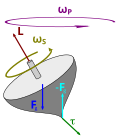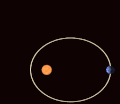Precession
Precession is a change in the orientation of the rotational axis of a rotating body. In physics, it refers to the slow movement of the axis of a spinning body around another axis due to the application of an external force, making the axis of rotation describe a cone in a cycle of movements. This phenomenon is observed in various contexts, including astronomy, gyroscopes, and spinning tops.
In astronomy, precession significantly impacts the Earth's rotation. The Earth's axis precesses with a period of approximately 26,000 years, a phenomenon known as the precession of the equinoxes. This precession is caused by the gravitational forces exerted by the Sun and the Moon on the Earth's equatorial bulge. As a result, the positions of the stars and constellations as seen from Earth slowly change over time, affecting celestial navigation and the calibration of astronomical observations.
Precession also plays a crucial role in the study of gyroscopes, devices that exploit the principles of conservation of angular momentum. Gyroscopes are used in various applications, including navigation systems for aircraft and spacecraft, where they help maintain orientation.
The concept of precession is further applied in the study of spinning tops. When a top spins, it often does not stand upright but instead precesses around its vertical axis due to the gravitational force acting on its center of mass.
Understanding precession is essential in fields such as physics, astronomy, and engineering, as it affects the design and operation of various instruments and devices, including telescopes, satellites, and navigation systems.
See Also[edit]
Precession[edit]
-
Gyroscope precession
-
Precession diagram
-
Gyroscopic precession
-
Precession of a top
-
Precessing Kepler orbit
Ad. Transform your life with W8MD's Budget GLP-1 injections from $75


W8MD offers a medical weight loss program to lose weight in Philadelphia. Our physician-supervised medical weight loss provides:
- Weight loss injections in NYC (generic and brand names):
- Zepbound / Mounjaro, Wegovy / Ozempic, Saxenda
- Most insurances accepted or discounted self-pay rates. We will obtain insurance prior authorizations if needed.
- Generic GLP1 weight loss injections from $75 for the starting dose.
- Also offer prescription weight loss medications including Phentermine, Qsymia, Diethylpropion, Contrave etc.
NYC weight loss doctor appointmentsNYC weight loss doctor appointments
Start your NYC weight loss journey today at our NYC medical weight loss and Philadelphia medical weight loss clinics.
- Call 718-946-5500 to lose weight in NYC or for medical weight loss in Philadelphia 215-676-2334.
- Tags:NYC medical weight loss, Philadelphia lose weight Zepbound NYC, Budget GLP1 weight loss injections, Wegovy Philadelphia, Wegovy NYC, Philadelphia medical weight loss, Brookly weight loss and Wegovy NYC
|
WikiMD's Wellness Encyclopedia |
| Let Food Be Thy Medicine Medicine Thy Food - Hippocrates |
Medical Disclaimer: WikiMD is not a substitute for professional medical advice. The information on WikiMD is provided as an information resource only, may be incorrect, outdated or misleading, and is not to be used or relied on for any diagnostic or treatment purposes. Please consult your health care provider before making any healthcare decisions or for guidance about a specific medical condition. WikiMD expressly disclaims responsibility, and shall have no liability, for any damages, loss, injury, or liability whatsoever suffered as a result of your reliance on the information contained in this site. By visiting this site you agree to the foregoing terms and conditions, which may from time to time be changed or supplemented by WikiMD. If you do not agree to the foregoing terms and conditions, you should not enter or use this site. See full disclaimer.
Credits:Most images are courtesy of Wikimedia commons, and templates, categories Wikipedia, licensed under CC BY SA or similar.
Translate this page: - East Asian
中文,
日本,
한국어,
South Asian
हिन्दी,
தமிழ்,
తెలుగు,
Urdu,
ಕನ್ನಡ,
Southeast Asian
Indonesian,
Vietnamese,
Thai,
မြန်မာဘာသာ,
বাংলা
European
español,
Deutsch,
français,
Greek,
português do Brasil,
polski,
română,
русский,
Nederlands,
norsk,
svenska,
suomi,
Italian
Middle Eastern & African
عربى,
Turkish,
Persian,
Hebrew,
Afrikaans,
isiZulu,
Kiswahili,
Other
Bulgarian,
Hungarian,
Czech,
Swedish,
മലയാളം,
मराठी,
ਪੰਜਾਬੀ,
ગુજરાતી,
Portuguese,
Ukrainian






